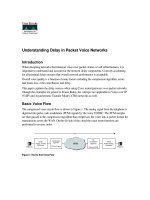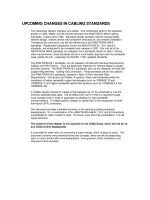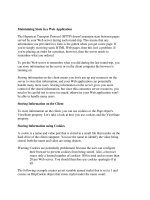Tài liệu Understanding Delay in Packet Voice Networks ppt
Bạn đang xem bản rút gọn của tài liệu. Xem và tải ngay bản đầy đủ của tài liệu tại đây (2.11 MB, 21 trang )
Understanding Delay in Packet Voice Networks
Introduction
When designing networks that transport voice over packet, frame, or cell infrastructures, it is
important to understand and account for the network delay components. Correctly accounting
for all potential delays ensures that overall network performance is acceptable.
Overall voice quality is a function of many factors including the compression algorithm, errors
and frame loss, echo cancellation, and delay.
This paper explains the delay sources when using Cisco router/gateways over packet networks.
Though the examples are geared to Frame Relay, the concepts are applicable to Voice over IP
(VoIP) and Asynchronous Transfer Mode (ATM) networks as well.
Basic Voice Flow
The compressed voice circuit flow is shown in Figure 1. The analog signal from the telephone is
digitized into pulse code modulation (PCM) signals by the voice CODEC. The PCM samples
are then passed to the compression algorithm that compresses the voice into a packet format for
transmission across the WAN. On the far side of the cloud the exact same functions are
performed in reverse order.
Telephone Telephone
Codec
Analog to PCM
Conversion
Codec
PCM to Analog
Conversion
Compression
Algorithm
PCM to Frame
De-
compression
Algorithm
Frame to PCM
WAN
Flow
Figure 1: End-to-End Voice Flow
© 2000, Cisco Systems, Inc. 2 04/02/2000
Cisco Confidential
Depending on how the network is configured, the router/gateway can perform the CODEC and
compression functions or only one of them. For example, when using an analog voice system the
router/gateway performs the CODEC function and the compression function as shown in Figure
2.
Telephone
Codec
Analog to PCM
Conversion
Compression
Algorithm
PCM to Frame
WAN
Router
Flow
V
Figure 2: CODEC Function in Router/Gateway
When using a digital PBX, the PBX performs the CODEC function, and the MC3810
processes the PCM samples passed to it by the PBX. An example is shown in Figure 3.
Telephone
Codec
Analog to PCM
Conversion
Compression
Algorithm
PCM to Frame
WAN
RouterPBX
Flow
V
Figure 3: CODEC Function in PBX
© 2000, Cisco Systems, Inc. 3 04/02/2000
Cisco Confidential
How Voice Compression Works
The high complexity compression algorithms used in Cisco router/gateways work by analyzing a
block of PCM samples delivered by the Voice CODEC. These blocks vary in length depending
on the coder. For example, the basic block size used by a G.729 algorithm is 10 ms whereas
the basic block size used by the G.723.1 algorithm is 30ms. An example of how a G.729
compression system works is shown in Figure 4.
Time
10ms 10ms
5 ms Look Ahead
T
0
T
1
A B C
10ms 20ms 30ms 40ms 50ms 0ms -10ms
Voice
Collect 10ms of PCM Samples
Figure 4: Voice Compression
The analog voice stream is digitized into PCM samples and delivered to the compression
algorithm in 10 ms increments.
Delay Limit Standards
The ITU considers network delay for voice applications in Recommendation G.114. This
recommendation defines three bands of one-way delay as show in Table 1.
Table 1: Delay Specifications
Range in
Millisecond
s
Description
0-150 Acceptable for most user applications.
150- 400 Acceptable provided administrators are aware of the transmission
time and its impact on the transmission quality of user applications.
Above 400 Unacceptable for general network planning purposes, however, it is
recognized that in exceptional cases this limit will be exceeded.
© 2000, Cisco Systems, Inc. 4 04/02/2000
Cisco Confidential
Note that these recommendations are for “connections with echo adequately controlled,” which
implies that echo cancellers are used. Echo cancelers are required when one-way delay exceeds
25 ms (G.131).
These recommendations are oriented for national telecom administrations (PTTs), and therefore
are more stringent than would normally be applied in private voice networks. When the location
and business needs of end users are well known to the network designer, more delay may be
acceptable. For private networks 200 ms of delay is a reasonable goal and 250 ms a limit, but
all networks should be engineered such that the maximum expected voice connection delay is
known and minimized.
Sources of Delay
There are two distinct types of delay, fixed and variable.
• Fixed delay components add directly to the overall delay on the connection.
• Variable delays arise from queuing delays in the egress trunk buffers on the serial port
connected to the WAN. These buffers create variable delays, called jitter, across the
network. Variable delays are handled by the de-jitter buffer at the receiving
router/gateway.
• Figure 5 identifies all the fixed and variable delay sources in the network. Each source is
described in detail in the following sections.
Fixed:
Switch
Delay
β
2
β
3
β
4
ω
1
ω
2
ω
3
E1
E1
64 Kbps
64 Kbps
Variable:
Output
Queuing
Delay
β
1
Fixed:
De-Jitter
Buffer
∆
1
Packet Flow
Fixed:
Packetization
Delay
π
1
Fixed:
Serialization
Delay
σ
1
Router
Router
σ
2
Fixed:
Coder
Delay
χ
1
V
V
Figure 5: Delay Sources
Coder (Processing) Delay (χ
n
)
Coder delay, also called processing delay, is the time taken by the DSP to compress a block of
PCM samples. Because different coders work in different ways, this delay varies with the voice
coder used and processor speed. For example, ACELP algorithms work by analyzing a 10 ms
block of PCM samples, and then compressing them.
© 2000, Cisco Systems, Inc. 5 04/02/2000
Cisco Confidential
The compression time for a CS-ACELP process ranges from 2.5 ms to 10 ms depending on
the loading of the DSP processor. If the DSP is fully loaded with four voice channels, the Coder
delay will be 10ms. If the DSP is loaded with only one voice channel the Coder delay will be
2.5 ms. For design purposes we will use the worst case time of 10ms.
Decompression time is roughly ten percent of the compression time for each block. However,
because there may be multiple samples in each frame (see Packetization Delay), the de-
compression time is proportional to the number of samples per frame. Consequently, the worst
case decompression time for a frame with three samples is 3 x 1ms or 3ms. Generally, two or
three blocks of compressed G.729 output are put in one frame while one sample of compressed
G.723.1 output is sent in a single frame.
Best and worst case coder delays are shown in Table 2.
Table 2: Best and Worst Case Processing Delay
Coder
Rate
Required
Sample
Block
Best Case
Coder
Delay
Worst Case
Coder
Delay
ADPCM, G.726 32 Kbps 10 ms 2.5 ms 10 ms
CS-ACELP,
G.729A
8.0 Kbps 10 ms 2.5 ms 10 ms
MP-MLQ, G.723.1 6.3 Kbps 30 ms 5 ms 20 ms
MP-ACELP,
G.723.1
5.3 Kbps 30 ms 5 ms 20 ms
Algorithmic Delay
The compression algorithm, which relies on known voice characteristics to correctly process
sample block N, must have some knowledge of what is in block N+1 to accurately reproduce
sample block N. This look ahead, which is an additional delay, is called algorithmic delay. The
algorithmic delay effectively increases the length of the compression block.
This happens repeatedly, such that block N+1 looks into block N+2, and so on. The net effect
is a 5 ms addition to the overall delay on the link. This means that the total time to process a
block of information is 10m with a 5 ms constant overhead factor. See Figure 4: Voice
Compression.
• Algorithmic Delay for G.726 coders is 0 ms
• Algorithmic Delay for G.729 coders is 5 ms.
• Algorithmic Delay for G.723.1 coders is 7.5 ms
© 2000, Cisco Systems, Inc. 6 04/02/2000
Cisco Confidential
For the examples in the remainder of this document, assume G.729 compression with a
30 ms/30 byte payload. To facilitate design and take a conservative approach, the following
tables assume the worst case Coder Delay. Additionally, for simplicity, the Coder Delay,
Decompression Delay, and Algorithmic delay are combined into one factor called Coder Delay.
The equation used to generate the lumped Coder Delay Parameter is:
Equation 1: Lumped Coder Delay Parameter
(Worst Case Compression Time Per Block)
(De-Compression Time Per Block)
X (Number of Blocks in Frame)
(Algorithmic Delay)
"Lumped" Coder Delay Parameter
=
+
+
The ‘lumped’ Coder delay for G.729 that we will use for the remainder of this document is:
Worst Case Compression Time Per Block: 10 ms
Decompression Time Per Block x 3 Blocks 3 ms
Algorithmic Delay 5 ms
Total (χ) 18 ms
© 2000, Cisco Systems, Inc. 7 04/02/2000
Cisco Confidential
Packetization delay (π
n
)
Packetization delay is the time taken to fill a packet payload with encoded/compressed speech.
This delay is a function of the sample block size required by the vocoder and the number of
blocks placed in a single frame. Packetization delay may also be called Accumulation delay, as
the voice samples accumulate in a buffer before being released.
As a general rule you should strive for a Packetization delay of no more than 30 ms. In the
Cisco router/gateways you should, based on configured payload size, use the following figures
from Table 3.
Table 3: Common Packetization Delays
Coder
Payload
Size
(Bytes)
Packetization
Delay (ms)
Payload
Size
(Bytes)
Packetization
Delay (ms)
PCM, G.711 64 Kbps 160 20 240 30
ADPCM, G.726 32 Kbps 80 20 120 30
CS-ACELP,
G.729
8.0 Kbps 20 20 30 30
MP-MLQ,
G.723.1
6.3 Kbps 24 24 60 48
MP-ACELP,
G.723.1
5.3 Kbps 20 30 60 60
Balance the Packetization delay against the CPU load. The lower the delay is, the higher the
frame rate, and the higher the load on the CPU. On some older platforms, 20 ms payloads may
strain the main CPU.
© 2000, Cisco Systems, Inc. 8 04/02/2000
Cisco Confidential
Pipelining Delay in the Packetization Process
Though each voice sample experiences both Algorithmic delay and Packetization delay, the
processes overlap and there is a net benefit effect from this pipelining. Consider the example
shown in Figure 1.
Time
10ms 10ms
Collect 10ms of PCM Samples
T
0
T
1
T
2
Compress first 10 ms block
(2.5 ms)
T
5
Compress Third 10 ms block
(2.5 ms)
10ms 20ms 30ms 40ms 50ms 0ms -10ms
T
6
Send 30 ms block of
compressed voice
Voice
T
3
T
4
Figure 6: Pipelining and Packetization
The top line of the figure depicts a sample voice waveform and the second line is a time scale in
10 ms increments. At T
0
, the CS-ACELP algorithm begins collecting PCM samples from the
CODEC. At T
1
, the algorithm has collected its first 10ms block of samples and begins
compressing it. At T
2
, the first block of samples has been compressed. Notice that in this
example the compression time is 2.5 ms, as indicated by T
2
-T
1
.
The second and third blocks are collected at T
3
and T
4
. The third block is compressed at T
5
and the packet assembled and sent (assumed to be instantaneous) at T
6
. Due to the pipelined
nature of the Compression and Packetization processes, the delay from when the process
begins to when the voice frame is sent is T
6
-T
0
, or approximately 32.5 ms.
For illustration, the example above is based on best case delay. If the worst case delay was
used the figure would be 40 ms, 10 ms for Coder delay and 30 ms for Packetization delay.
Note that the above examples neglect to include algorithmic delay.









